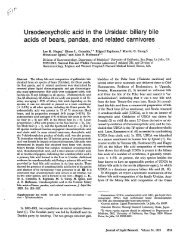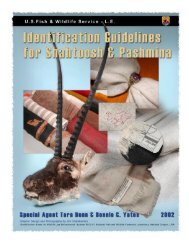The Identification of Sodium Fluoroacetate (Compound 1080 ...
The Identification of Sodium Fluoroacetate (Compound 1080 ...
The Identification of Sodium Fluoroacetate (Compound 1080 ...
You also want an ePaper? Increase the reach of your titles
YUMPU automatically turns print PDFs into web optimized ePapers that Google loves.
sample in 1.5mL D20 containing DSS. Undissolved solid was filtered<br />
through a Pasteur pipette fitted with a cotton plug. Samples<br />
that were liquids were heated in an open atmosphere or under water<br />
pump vacuum to remove the solvent. <strong>The</strong> remaining residue was<br />
then treated in a similar manner as the solid samples. All 1H NMR<br />
spectra were recorded at 270.05 MHz employing a spectral width<br />
<strong>of</strong> 5405.4 Hz (-1.0 to 19.0 ppm), a 3.0 second pulse delay, and a<br />
5.7 J.Lsecpulse width. Single Pulse with Broadband Decoupling l3C<br />
NMR spectra were recorded at 67.80 MHz with an 18,050 Hz spectral<br />
width (-24 to 242 ppm), a 5,400 Hz irradiation frequency, a 3.0<br />
J.Lsecpulse width, and a 1.00 sec pulse delay. Distortionless Enhanced<br />
Polarization Transfer (DEPT) spectra were collected using<br />
the DEPTEDIT2 program (provided with the instrument s<strong>of</strong>tware)<br />
run at 67.80 MHz with an 18,050 Hz spectral width (- 24 to 242<br />
ppm), a 5,400 Hz irradiation frequency, an 8.7 J.Lsecpulse width,<br />
and a 2.5 sec pulse delay.<br />
<strong>The</strong> examination <strong>of</strong> the 1Hand l3C spectra <strong>of</strong> sodium fluoroacetate<br />
arose out <strong>of</strong> a study <strong>of</strong> two samples sent to the National Fish<br />
and Wildlife Forensics Laboratory for analysis. One sample arrived<br />
as a purple colored liquid, the other as an <strong>of</strong>f-white solid.<br />
Running 1Hand l3C NMR spectra to confirm the identities <strong>of</strong><br />
these samples was an attractive option given that an NMR spectrometer<br />
was readily available. It was expected that manipulation<br />
<strong>of</strong> the samples would be minimal, and that the analyses could be<br />
done very quickly. Indeed, lH and l3C spectra turned out to provide<br />
a facile and uncompromisingly clear identification <strong>of</strong> <strong>Compound</strong><br />
<strong>1080</strong>.<br />
<strong>The</strong> unfluorinated analog <strong>of</strong> sodium fluoroacetate is sodium acetate.<br />
Its lH NMR spectrum consists <strong>of</strong> a lone singlet at 1.9 ppm,<br />
which is indicative <strong>of</strong> the methyl group adjacent to the carbonyl.<br />
<strong>The</strong> effect <strong>of</strong> substitution <strong>of</strong> a fluorine atom in place <strong>of</strong> one <strong>of</strong> the<br />
hydrogens on the methyl group <strong>of</strong> sodium acetate should be quite<br />
u ... .. •.1<br />
\...<br />
..•<br />
obvious in the 1H NMR spectrum <strong>of</strong> sodium fluoroacetate. In running<br />
NMR spectra <strong>of</strong> the lab samples suspected <strong>of</strong> being sodium<br />
fluoroacetate, it was expected that the presence <strong>of</strong> fluorine would<br />
be indicated by a significant downfield chemical shift <strong>of</strong> the hydrogens<br />
<strong>of</strong> the -CH2F group, and, because 19Fand lH can undergo<br />
geminal coupling, one should observe a doublet for the<br />
-CH2F system <strong>of</strong> the fluoroacetate. Indeed, this is what was ultimately<br />
observed. Figure I is the lH NMR spectrum <strong>of</strong> one <strong>of</strong> the<br />
lab samples received as a liquid for analysis. <strong>The</strong> initial attempt<br />
at taking the spectrum yielded only a large H20 signal, which<br />
confirmed the nature <strong>of</strong> the solvent that the sample was dissolved<br />
in. Removal <strong>of</strong> excess water yielded a slightly more useful spectrum,<br />
albeit, not a conclusive one. Water still remained in the<br />
sample and was responsible for the broad signal observed at 4.8<br />
ppm. <strong>The</strong> small signal at 4.61 ppm is one half <strong>of</strong> a doublet centered<br />
at 4.70 ppm; the other half <strong>of</strong> the doublet being obscured by<br />
the water signal. Such a doublet at 4.70 ppm fits the characteristics<br />
<strong>of</strong> the CH2F group <strong>of</strong> fluoroacetate in regards to chemical<br />
shift and multiplicity. To verify the presence <strong>of</strong> the doublet, a<br />
very simple variable temperature NMR experiment was done, the<br />
results <strong>of</strong> which are seen in Fig. 2. <strong>The</strong> same sample was heated<br />
to 60°C, and the 1H NMR spectrum re-taken. Changes in hydrogen<br />
bonding characteristics at higher temperatures caused a shift<br />
<strong>of</strong> the water signal to a more upfield position, thus affording a<br />
clear confirmation <strong>of</strong> the presence <strong>of</strong> the anticipated --cH2F doublet.<br />
<strong>The</strong> equivalent integration signals <strong>of</strong> the peaks at 4.78 and<br />
4.63 ppm lend credence to this assertion. <strong>The</strong> presence <strong>of</strong> the fluorine<br />
in the molecule was also supported through the IH _ 19 F<br />
coupling that was observed. Geminal 19F_ 1 H coupling constants<br />
are notably large, and so, the 48 Hz 19F_ 1 H coupling constant<br />
that was found for the --eH2F doublet was in accord with our expectations<br />
(20). <strong>The</strong> IH NMR spectra taken <strong>of</strong> this lab sample<br />
were in complete agreement with those taken <strong>of</strong> a <strong>1080</strong> sample<br />
obtained from the EPA.<br />
<strong>The</strong> l3C proton decoupled NMR spectra <strong>of</strong> sodium fluoroacetate<br />
A<br />
..•<br />
PPM<br />
"i'I'I'.'!"';"') •• '!')""'I."!".'."", •• ""."liiiiiiliili'i'illii,liiiiiiiiiliiiiiii"Iij'jiiiiililiiiiiiilJiiliiiiitiiiiiiiii(iii<br />
5.5 5.0 4~5 4.0 3.5 3.0 2.5 2.0 1.5 1.0 0.5 0.0 ~.5 -1.0<br />
-




